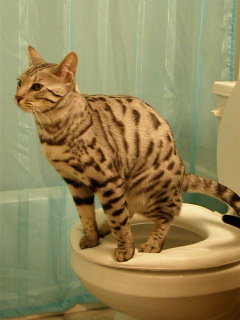How do you actually feel in relation to Don’t flush cat feces down the toilet?

Intro
As pet cat owners, it's important to bear in mind how we get rid of our feline pals' waste. While it might appear hassle-free to purge cat poop down the toilet, this practice can have damaging consequences for both the atmosphere and human wellness.
Ecological Impact
Flushing cat poop presents harmful microorganisms and bloodsuckers right into the water supply, positioning a substantial threat to water ecosystems. These contaminants can negatively affect aquatic life and concession water top quality.
Health and wellness Risks
In addition to environmental worries, purging feline waste can also pose health dangers to human beings. Cat feces may have Toxoplasma gondii, a bloodsucker that can trigger toxoplasmosis-- a potentially severe illness, particularly for expectant women and people with weakened body immune systems.
Alternatives to Flushing
Fortunately, there are more secure and more liable ways to get rid of cat poop. Think about the following options:
1. Scoop and Dispose in Trash
The most typical approach of throwing away cat poop is to scoop it into an eco-friendly bag and toss it in the trash. Be sure to use a specialized trash inside story and get rid of the waste immediately.
2. Use Biodegradable Litter
Choose eco-friendly feline trash made from materials such as corn or wheat. These trashes are environmentally friendly and can be safely disposed of in the trash.
3. Hide in the Yard
If you have a lawn, think about hiding pet cat waste in a marked area away from vegetable yards and water sources. Make certain to dig deep adequate to stop contamination of groundwater.
4. Mount a Pet Waste Disposal System
Purchase an animal garbage disposal system especially made for feline waste. These systems utilize enzymes to break down the waste, lowering odor and environmental effect.
Verdict
Responsible pet dog possession prolongs beyond supplying food and sanctuary-- it also includes proper waste management. By avoiding purging cat poop down the toilet and going with alternative disposal techniques, we can decrease our ecological footprint and protect human health and wellness.
Why Can’t I Flush Cat Poop?
It Spreads a Parasite
Cats are frequently infected with a parasite called toxoplasma gondii. The parasite causes an infection called toxoplasmosis. It is usually harmless to cats. The parasite only uses cat poop as a host for its eggs. Otherwise, the cat’s immune system usually keeps the infection at low enough levels to maintain its own health. But it does not stop the develop of eggs. These eggs are tiny and surprisingly tough. They may survive for a year before they begin to grow. But that’s the problem.
Our wastewater system is not designed to deal with toxoplasmosis eggs. Instead, most eggs will flush from your toilet into sewers and wastewater management plants. After the sewage is treated for many other harmful things in it, it is typically released into local rivers, lakes, or oceans. Here, the toxoplasmosis eggs can find new hosts, including starfish, crabs, otters, and many other wildlife. For many, this is a significant risk to their health. Toxoplasmosis can also end up infecting water sources that are important for agriculture, which means our deer, pigs, and sheep can get infected too.
Is There Risk to Humans?
There can be a risk to human life from flushing cat poop down the toilet. If you do so, the parasites from your cat’s poop can end up in shellfish, game animals, or livestock. If this meat is then served raw or undercooked, the people who eat it can get sick.
In fact, according to the CDC, 40 million people in the United States are infected with toxoplasma gondii. They get it from exposure to infected seafood, or from some kind of cat poop contamination, like drinking from a stream that is contaminated or touching anything that has come into contact with cat poop. That includes just cleaning a cat litter box.
Most people who get infected with these parasites will not develop any symptoms. However, for pregnant women or for those with compromised immune systems, the parasite can cause severe health problems.
How to Handle Cat Poop
The best way to handle cat poop is actually to clean the box more often. The eggs that the parasite sheds will not become active until one to five days after the cat poops. That means that if you clean daily, you’re much less likely to come into direct contact with infectious eggs.
That said, always dispose of cat poop in the garbage and not down the toilet. Wash your hands before and after you clean the litter box, and bring the bag of poop right outside to your garbage bins.
https://trenchlesssolutionsusa.com/why-cant-i-flush-cat-poop/

I recently found that blog posting on How to Dispose of Cat Poop and Litter Without Plastic Bags while surfing the search engines. Liked our write-up? Please share it. Let another person locate it. Bless you for your time. Kindly stop by our site back soon.
Find Out More